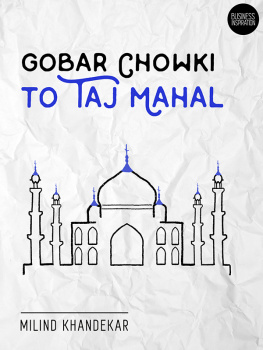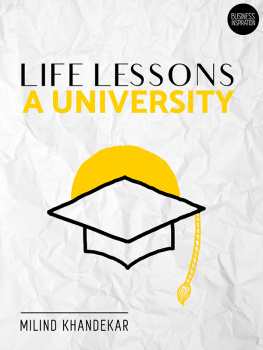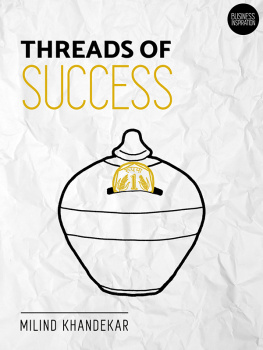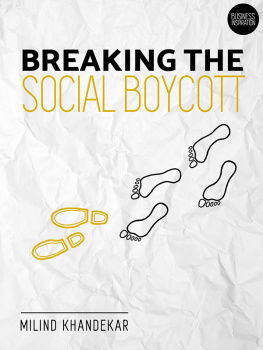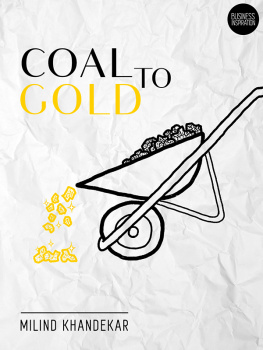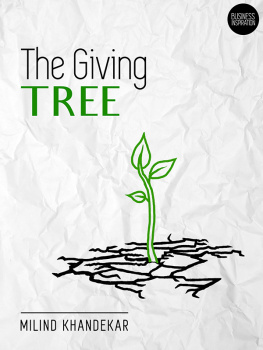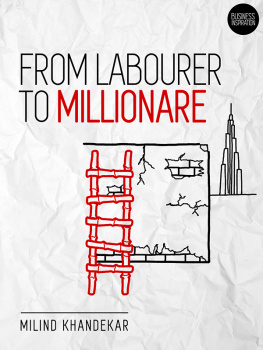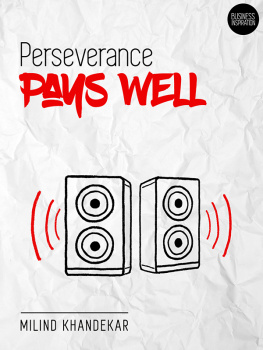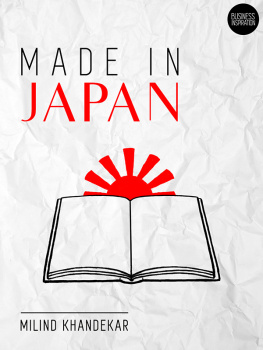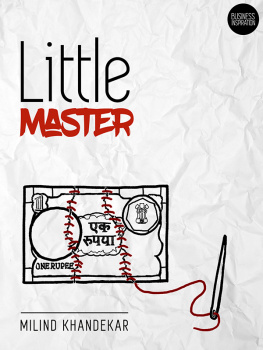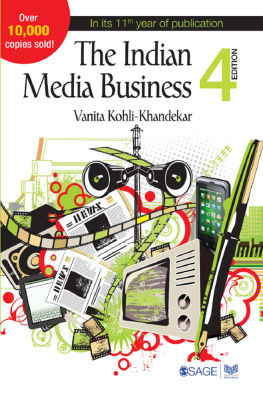Khandekar - GOBAR CHOWKI TO TAJ MAHAL
Here you can read online Khandekar - GOBAR CHOWKI TO TAJ MAHAL full text of the book (entire story) in english for free. Download pdf and epub, get meaning, cover and reviews about this ebook. year: 2017, publisher: Penguin Books Ltd, genre: Children. Description of the work, (preface) as well as reviews are available. Best literature library LitArk.com created for fans of good reading and offers a wide selection of genres:
Romance novel
Science fiction
Adventure
Detective
Science
History
Home and family
Prose
Art
Politics
Computer
Non-fiction
Religion
Business
Children
Humor
Choose a favorite category and find really read worthwhile books. Enjoy immersion in the world of imagination, feel the emotions of the characters or learn something new for yourself, make an fascinating discovery.
GOBAR CHOWKI TO TAJ MAHAL: summary, description and annotation
We offer to read an annotation, description, summary or preface (depends on what the author of the book "GOBAR CHOWKI TO TAJ MAHAL" wrote himself). If you haven't found the necessary information about the book — write in the comments, we will try to find it.
GOBAR CHOWKI TO TAJ MAHAL — read online for free the complete book (whole text) full work
Below is the text of the book, divided by pages. System saving the place of the last page read, allows you to conveniently read the book "GOBAR CHOWKI TO TAJ MAHAL" online for free, without having to search again every time where you left off. Put a bookmark, and you can go to the page where you finished reading at any time.
Font size:
Interval:
Bookmark:
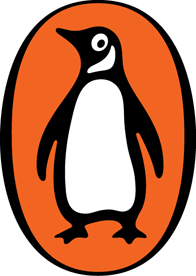
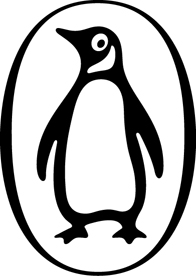



UK | Canada | Ireland | Australia
New Zealand | India | South Africa
Penguin Books is part of the Penguin Random House group of companies whose addresses can be found at global.penguinrandomhouse.com.

Copyright Milind Khandekar 2013
The moral right of the author has been asserted
This digital edition published in 2016.
e-ISBN: 978-9-386-65181-5
This book is sold subject to the condition that it shall not, by way of trade or otherwise, be lent, resold, hired out, or otherwise circulated without the publishers prior consent in any form of binding or cover other than that in which it is published and without a similar condition including this condition being imposed on the subsequent purchaser.


Let the conversation begin...
Follow the Penguin Twitter.com@PenguinIndia
Keep up-to-date with all our stories YouTube.com/PenguinIndia
Like Penguin Books on Facebook.com/PenguinIndia
Find out more about the author and
discover more stories like this at penguinbooksindia.com
PENGUIN
Milind Khandekar has over twenty-two years of experience in the field of journalism. He is currently managing editor at Media Content and Communications Services (I) Pvt. Ltd (MCCS), and looks after the editorial content of ABP News, ABP Ananda and ABP Majha. He has previously worked with the Navbharat Times and Aaj Tak. He is a product of the Times Centre for Media Studies, and received the Rajendra Mathur Award for best trainee (Hindi) in 1991.

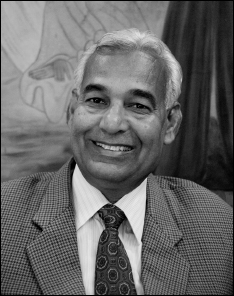
Devkinandan Son is the subject of the acclaimed documentary film A Nation Celebrates. Commissioned by the Ministry of External Affairs and directed by Kabir Khan (whose last film was the Salman Khan starrer Ek Tha Tiger), the film was made to mark fifty years of Indias independence. In the film, renowned actor Roshan Seths sombre voice asks, What significance does the Taj Mahal have for Gobar Chowki? A Jatav neighbourhood, Gobar Chowki stands close to the Taj Mahal in Agra. The Mughals had white marble loaded on to beasts of burden and carried off to the Taj Mahal. Over a period of time, animal dung got accumulated here and the area came to known as Gobar Chowkigobar meaning dung. The film narrates Devkinandans success storyshowing how he moved out of Gobar Chowki into a palatial mansion after transforming an inconsequential shoe business into a mega enterprise.
However, the film, made fifteen years ago, only celebrates one part of Devkinandans lifesince then, his story has developed further. As recently as twenty-five years ago, his home was a room in Gobar Chowki. Today, in another direction, barely half a kilometre from the Taj, stands his forty-room hotel, the Taj Plaza. Now, his son Siddhartha Nandan runs it, while his younger son looks after the shoe business, which even has a market in Europe. Devkinandan is wary of sharing the exact turnover of his business, and reveals a drastically reduced figure, saying one could assume that both businesses put together have a turnover of about Rs 1 crore.
But Devkinandans story is not one of turnovers. He was studying in class nine when he was forced to quit school to help his father, whom he calls Pitaji (father). He still remembers that Dussehra day when his father told his mother about his feeling of complete helplessness and his inability to earn enough to send their children to school.
Devkinandan was good at studies and showed me his mark-sheet which showed that he had received 99 per cent in the Arts stream. But Pitajis shoe business was running at a lossthe shoes hadnt fetched enough in the market to cover the production costand so, Devkinandan, being the eldest of the three brothers, had to start working. In the beginning, his job was to wrap shoes in paper and pack them into a box. He packed over a hundred pairs of shoes every day and earned about Rs 60 a month or Rs 2 per day.
It was while doing this work that he happened to see a newspaper advertisement for the Central Footwear Training Institute (CFTI). The Government of India had set up these institutes in Agra and Chennai to teach new footwear production techniques. In 1971, Devkinandan was accepted at CFTI and started off with a stipend of Rs 75 per month, but continued with his packing job to add to his earnings. Pitaji was happy that his son had moved up from being a worker to being a designer.
Though its a commonly heard grievance that government schemes dont benefit those who really need the help, the government did play a major role in taking Devkinandans life forwardfirst through the CFTI and then through the Uttar Pradesh governments Leather Development and Marketing Corporation. However, Devkinandan couldnt start his business for three years after being trained at the institute because he faced the same challenge his father hadit was difficult to recover the cost incurred in making shoes.
Earlier on, every evening, Devkinandan used to carry around twenty-five pairs of shoes to Hing ki Mandi, a major shoe market, the venue for some serious bargaining. Prices could be pushed very low, and there was no guarantee of earning even Rs 5 for a pair of shoes.
It was around this time that Devkinandan realized that in the shoe business the role of the Jatav community was limited to the actual crafting of the shoethey were nowhere in the picture when the selling of raw material or the buying of ready products was concerned, as this aspect required a fair amount of money. Luckily, in 1975, he got a break when an Uttar Pradesh government organization placed a large order with Devkinandan. He made Rs 5 on every pair of shoes he supplied. Unfortunately, however, the government organization ran into rough weather, and in 1980, Devkinandan had to once again wind up his business.
Devkinandan got his next break while working for Teja Shoes. In 1983, a huge exhibition of shoes was held at Agras Clarks Shiraz hotel, where the company showcased Devkinandans designs. Thomas Bata, the man behind Bata shoes, liked his designs and offered him a deal requiring him to produce 10,000 pairs of shoes for Bata, West Indies. With each pair priced at Rs 400, this bulk order of Rs 40 lakh changed Devkinandans life. Due to the involvement of the Bata brand name, it was easy to procure raw material like leather, on credit, and spared him from engaging in petty bargaining with Bata la Hing ki Mandi.
Font size:
Interval:
Bookmark:
Similar books «GOBAR CHOWKI TO TAJ MAHAL»
Look at similar books to GOBAR CHOWKI TO TAJ MAHAL. We have selected literature similar in name and meaning in the hope of providing readers with more options to find new, interesting, not yet read works.
Discussion, reviews of the book GOBAR CHOWKI TO TAJ MAHAL and just readers' own opinions. Leave your comments, write what you think about the work, its meaning or the main characters. Specify what exactly you liked and what you didn't like, and why you think so.

